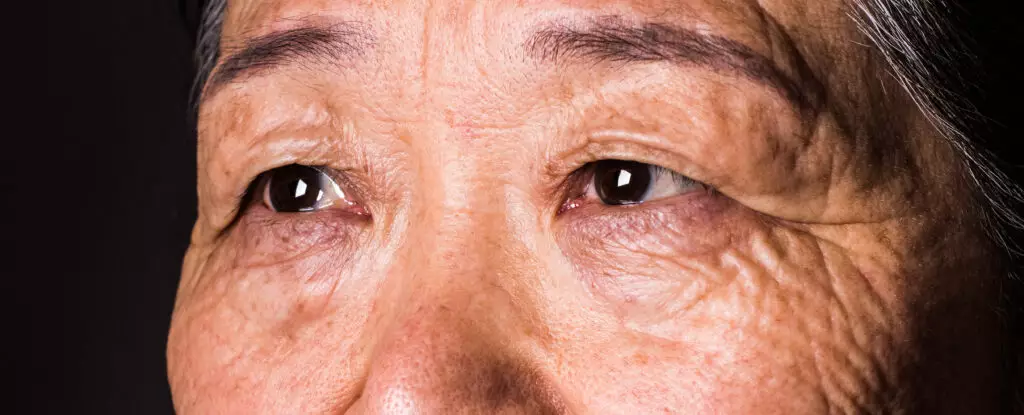The connection between our eyesight and cognitive health is more profound than many recognize. Recent findings suggest that visual sensitivity can serve as an early indicator of dementia, potentially appearing up to a decade before formal diagnosis becomes possible. This compelling notion invites us to delve deeper into how eye health can mirror—if not foreshadow—our mental acuity.
The study conducted in Norfolk, England, which monitored 8,623 healthy individuals over a significant period, paints a revealing picture. By the conclusion of the study, 537 participants were found to develop dementia, allowing researchers to unearth correlations between visual performance and cognitive decline. Utilizing a simple visual sensitivity test, participants were tasked with detecting a triangle amidst animated dots on a screen. The results were telling: those who eventually faced dementia exhibited delays in recognizing the triangle compared to those who remained cognitively intact.
Visual Impairment: A Prelude to Cognitive Decline
So what underlies this link between vision and cognition? One plausible explanation stems from the nature of Alzheimer’s disease itself. The progression of this debilitating condition is intricately tied to the accumulation of toxic amyloid plaques, which initially impact brain regions responsible for visual processing. Only as the condition advances do areas related to memory suffer significant damage. This means that traditional memory-based assessments may overlook early deficits, making visual tests crucial for early diagnosis.
Moreover, visual processing elements like contrast sensitivity—our ability to distinguish between shades and outlines—tend to falter in the thriving context of Alzheimer’s disease. Furthermore, studies indicate that the early stages of dementia affect color perception, particularly within the blue-green spectrum. Such subtle but significant changes can impede daily activities, although individuals may be unaware of their gradual decline in visual acuity.
Even more intriguing is the phenomenon of “inhibitory control” over eye movements. Individuals with Alzheimer’s exhibit heightened distractibility, as competing stimuli appear more compelling than usual. This lack of focus can impair activities like driving, raising alarms about public safety as we continue to study these implications at institutions like Loughborough University.
Eye Movements: A New Dimension in Diagnosing Dementia
The nuances of how people with dementia interact with their environment yield additional insights. For instance, deficits in their ability to scan faces disrupt the natural pattern—moving from eyes to nose to mouth—that we typically adopt during social interactions. This disconnection can lead to a sense of social isolation and confusion as individuals struggle to recognize newly met acquaintances. Consequently, the inability to effectively engage with and imprint visual details exacerbates memory challenges, blurring the line between visual and cognitive disorders.
The interplay between eye movements and memory prompts us to reconsider potential therapeutic approaches. Research indicates that intentionally engaging in eye movements may enhance memory performance, with previous studies revealing a correlation between individuals who actively utilize their vision—through reading or watching television—and their overall cognitive health. These activities not only stimulate eye muscles but potentially forge new neural pathways, thereby fortifying cognitive reserve.
However, while promising, the benefits of deliberate eye movement practices seem inconsistent across various demographics, with evidence suggesting a disparity in effectiveness between right-handed and left-handed individuals. The reasons for this discrepancy remain elusive, yet they underscore the complexity of the human brain and its relationship with sensory perception.
Barriers to Harnessing Eye Movement Diagnostics
Despite the exciting prospects, the translation of visual diagnostics into practical usage faces several hurdles. The accessibility of eye-tracking technology, often costly and requiring extensive training for accurate analysis, presents a significant hurdle. Until we democratize this innovative technology, using eye movements as a diagnostic measure for early-stage Alzheimer’s in everyday clinical settings remains largely confined to research laboratories.
The potential to revolutionize early dementia detection through routine eye assessments offers a beacon of hope for those immersed in the realms of neuroscience and geriatrics. As we expand our understanding of the eye-brain connection, the emphasis on holistic approaches toward cognitive health gains urgency. Future innovations should propel this vision forward, enabling healthcare providers to integrate visual sensitivity assessments into broader cognitive screenings. The implications for improved early detection and intervention could transform the landscape of dementia care, offering those at risk a fighting chance against the encroaching shadows of cognitive decline.

